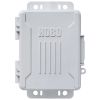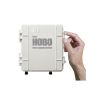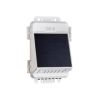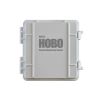HOBO PAR Smart Sensor
Features
- Measurement range of 0 to 2500 umol/m2/sec over wavelengths from 400 to 700 nm
- Plug-n-play smart sensor
- Compatible with H21, U30, RX2100, and RX3000 family loggers
- Free ground shipping
- Expedited repair and warranty service
- Lifetime technical support
- More
Overview
The Onsite Photosynthetic Light (PAR) Smart Sensor measures light intensity for the frequencies relevant to photosynthesis. This sensor has a measurement range of 0 to 2500 umol/m2/sec over wavelengths from 400 to 700 nm. Enclosed in an anodized aluminum housing with an acrylic diffuser and o-ring seal, this model has a 3m cable. Sold separately, a light sensor bracket and light sensor level are recommended.
Measurement Parameters: average over logging interval, user-defined sampling interval from 1 second
Measurement Range: 0 to 2500 umol/m2/sec, wavelengths of 400 to 700 nm
Operating Temperature Range: -40° to 75°C (-40° to 167°F)
Accuracy: ±5 umol/m2/sec or ± 5%, whichever is greater in sunlight; additional temperature-induced error ±0.75 umol/m2/sec/degree C from 25°C. Cosine corrected 0 - 80 degrees, 360 degree rotation.
Resolution: 2.5 umol/m2/sec
Drift: <±2% per year
Housing: anodized aluminum housing with acrylic diffuser and o-ring seal
Dimensions: 4.1 cm height x 3.2.4 cm diameter (1 5/8" height x 1 1/4" diameter)
Approximate Weight: 120 g (4 oz)
Cable Length: 3 meter (10')
Length of Smart Sensor Network Cable: 3m
In The News
Research in the Reserve: Promoting Interdisciplinary Conservation at the Great Bay National Estuarine Research Reserve
On an early winter day in 1973, a helicopter buzzed over Durham, New Hampshire, just a few miles from the Atlantic Ocean. One of the helicopter’s guests, oil magnate Aristotle Onassis, owner of Olympic Refining, looked east of town and saw what he hoped would become the world’s largest oil refinery. Instead, he saw the Great Bay; thousands of acres of green coastal forest, mud flats, salt marshes, and estuarine tidal waters stretching over the land toward New Hampshire's small Eastern coastline. Onassis likely also saw a group of Durham residents staked out on the bay’s coast, ready for him to pass overhead. While out of place in the natural setting, an obvious message was spelled out in red paper: “Not Here.
Read MoreFloating Global New Ideas: Buoy-Enabled Research at Florida Agricultural and Mechanical University’s School of the Environment
Florida Agricultural and Mechanical University (FAMU), based in Tallahassee, Florida, is the highest-rated public Historically Black College or University in the United States. FAMU’s School of the Environment (FAMU-SOE) offers BS and BA degrees in Environmental Studies, and BS, MS, and Ph.D. degrees in Environmental Science, with specialisms available in areas including Environmental Policy and Risk Management, Aquatic and Terrestrial Ecology, and Biomolecular Sciences. In 2021, FAMU-SOE deployed a NexSens CB-450 buoy in Apalachee Bay, a key oyster farming area around 30 miles south of Tallahassee. The buoy has quickly been incorporated into the curriculum, providing environmental insights for student research, the community, and beyond. Dr.
Read MoreMonitoring Habitat Suitability and Water Quality in Northwest Arkansas Springs
Northwest Arkansas has seen an economic, industrial, and population boom in recent years as a result of expanding businesses, which have created thousands of jobs in the region and the mass migration of employees and construction companies. However, with this growth has come rapid urbanization and the degradation of the natural landscape, specifically the freshwater springs that can be found throughout the region. These springs are critical habitat centers for native wildlife, home to threatened and endangered fish, and those that have yet to be listed. Zach Moran, Assistant Professor of Fisheries Science at Arkansas Technical University, is working to help monitor these habitats and provide key data that will hopefully inform future development in the region.
Read More



















